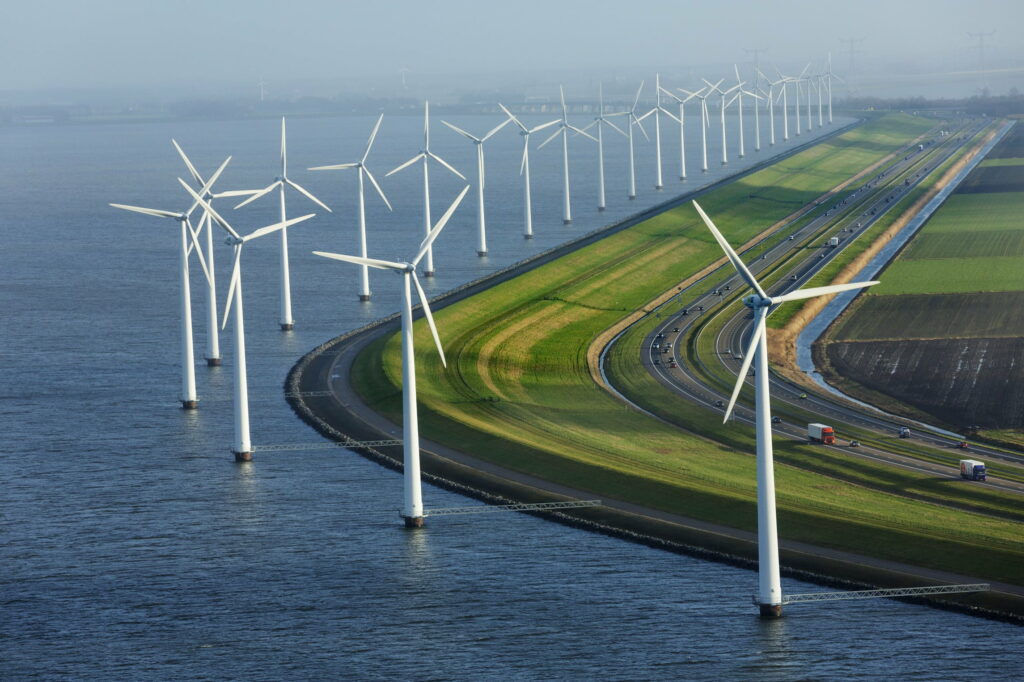Defying the grimmest projections, Europe made it through the temperate winter of 2023 with remarkably little collateral damage – and even a few big wins. The energy crisis may have displaced Europe’s climate aspirations by a fraction, but thanks to a record rollout of renewables and conservation measures, the continent’s emissions footprint inched downward and positioned Europe to remain within reach of its goal to slash emissions by 55 percent in seven years’ time. And it’s on track to comfortably outpace its pledge to generate 45% of its total energy from clean sources by 2030.

“We did it!,” proclaimed Germany’s daily, Süddeutsche Zeitung in late February. “No freezing, no unrest, no mass bankruptcy. Russia’s weaponizing of gas has been disabled. Germany and Europe have bought themselves valuable time.”
Late last year, ordinary citizens and industry leaders alike feared the onset of a dire winter of deprivation, spiraling energy prices, unheated homes, and work stoppages. After all, embargoes in place as a result of Russia’s attack on Ukraine had truncated gas and oil deliveries to many countries, and upended the supply chains that much of Europe had come to rely upon.
But, in terms of climate protection, Lauri Myllyvirta of the Center for Research on Energy and Clean Air, an independent Finnish research institute, told Yale Environment 360 that Europe made a quantum leap in 2022, largely a result of the extraordinarily high fossil fuel prices that spurred energy savings, faster-than-ever clean tech deployment, and ramped up EU policies. “This portends Europe’s nearly complete phase-out of coal and a substantial reduction in natural gas generation in the power sector by 2030. We’re moving in that direction now,” says Myllyvirta.
Clean tech boom and conservation keep climate goals within reach
The secret to Europe’s mettle was above all its expansive solar fields and wind farms whose generation jumped by 15 percent over 2021, offsetting the deleterious coal burning, and overtaking both gas and nuclear in electricity generation for the first time.
Wind power, the presumptive backbone of Europe’s future electricity supply, came through with the heavy lifting. On and offshore wind farms covered 17 percent of EU power demand in 2022, roughly the generation volume of 255 medium-sized nuclear reactors (= 255 GW).
The breakout performers were the clean tech investments that could be deployed in a hurry, by ordinary citizens and businesses: namely household solar, EVs, and residential heat pumps. “Solar panels can be bought online, e-cars at a local car dealership,” says Myllyvirta. The investment of home owners helped boost solar generation across the EU by 24 percent.
Heat pumps are more involved, he notes, but 2022 smashed all sales records: three million new installations, a 38 percent jump over 2021. Limited supplies, not demand, and skilled labor shortages, he claims, held back all three technologies from growing even more. “But the demand signals are pushing suppliers to scale up as fast as possible,” says Myllyvirta.
The surge in clean energy technologies not only filled in for the missing Russian gas, but also helped offset the loss of about a fifth of the nuclear and hydropower generated last year, a phenomenon that raises ominous questions about these energy sources’ reliability in the future – in Europe and beyond. The fall in nuclear resulted largely from France’s chronically ailing fleet, while hydroelectric suffered from exceptional summer drought conditions.
The EU, an institution that rarely misses the opportunity to capitalize on a crisis, set into motion an ambitious updating of the Green Deal that would rapidly reduce dependence on Russian fossil fuels by 2027 and fast forward the green transition. It ratcheted up its renewable energy target from 40 to 45 percent, pushed forward binding efficiency measures, and pledged to find €210bn to spend on new energy infrastructure.
Work in Progress
Critics also worry that the new high-ticket LNG ports on the North and Baltic Sea could “lock in” natural gas supplies for years or even decades to come. The temporarily leased floating units and permanent land-based import terminals are, argues Germany’s foremost climate activist Luisa Neubauer, “massively oversized LNG projects without an overall concept, which in the worst case could lead to an overcapacity of 50 percent.”
Europe is anything but out of the woods, says the IEA. Next winter, the EU is staring at a potential shortfall of almost 30 billion cubic meters of natural gas. Perhaps most daunting, the EU itself estimates that it must nearly double its renewable power generation by 2030 just to hit its own emissions targets. The winter of 2023-24 might make the most recent winter look cozy.